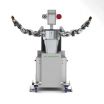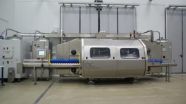(Press-News.org) Montreal, December 22, 2010 – Obese people are more likely to report exercise as a trigger for asthma. Of 673 people evaluated in a new study whose results are published in the journal The Physician and Sportsmedicine, 71 percent of participants reported exercise-induced asthma (ETA).
The findings are important, since 2.3 million Canadians are affected by asthma according to Statistics Canada.
ETA affects up to 90 percent of asthma sufferers, says lead author Simon Bacon, a professor at the Concordia Department of Exercise Science and a researcher at the Hôpital du Sacré-Coeur de Montréal. "Compared with normal-weight participants, patients who were overweight or obese were more likely to report ETA. To our knowledge, there are no studies that have explored this relationship," he says. "We also found that for every one-point increase in body mass index score was associated with a 9 percent increase in the probability of reporting exercise-induced asthma."
Participants who took part in the investigation suffered from intermittent as well as mild, moderate and severe persistent asthma. Their body mass index was calculated according to their reported height and weight. Patients were also asked to indicate factors – exercise, animals, dust, pollen, aspirin, stress, emotions or cold air – that could trigger their asthma.
"Exercise-induced asthma may lead to a sedentary lifestyle, increased weight and can fuel a downward spiral to worsened health," says Dr. Bacon. "Given the importance of exercise and regular physical activity in weight management, greater care should be taken when working with asthma patients to refer them to appropriate weight management specialists to help them control and safely reduce their weight."
INFORMATION:
Partners in research:
The study was funded by the Social Sciences and Humanities Research Council, the Canadian Institute of Health Research and the Fonds de la Recherche en Santé du Québec.
About the study:
The article, "Effect of Body Mass Index on Self-Reported Exercise-Triggered Asthma," published in the journal The Physician and Sportsmedicine, was coauthored by Simon L. Bacon, Amanda Rizk and Alicia Wright of Concordia University and the Hôpital du Sacré-Coeur de Montréal; Kim L. Lavoie and Ariane Jacob of the Université du Québec à Montréal and the Hôpital du Sacre-Coeur de Montréal.
On the Web:
Cited study from The Physician and Sportsmedicine: http://www.physsportsmed.com/index.php?article=1826
Concordia University: www.concordia.ca
Université du Québec à Montréal: www.uqam.ca
Hôpital du Sacré-Coeur de Montréal : www.hscm.ca
Media contact:
Sylvain-Jacques Desjardins
Senior advisor, media relations
University Communications Services
Concordia University
Phone: 514-848-2424, ext. 5068
Email: s-j.desjardins@concordia.ca
Twitter: http://twitter.com/concordianews
END
Why do people choose present consumption over their long-term financial interests? A new study in the Journal of Consumer Research finds that consumers have trouble feeling connected to their future selves.
"This willingness to forego money now and wait for future benefits is strongly affected by how connected we feel to our future self, who will ultimately benefit from the resources we save," write authors Daniel M. Bartels (Columbia Business School) and Oleg Urminsky (University of Chicago).
When we think of saving money for the future, the person we think of can ...
Although it is the third most frequent cause of death in Germany, blood poisoning is frequently underestimated. In this country, 60,000 persons die every year from some form of sepsis, almost as many as from heart attacks. The Sepsis Nexus of Expertise states that patients arriving at the intensive care ward with blood poisoning only have a 50% chance of surviving. One of the reasons for the high mortality rate is the fact that patients are not correctly treated due to late diagnosis. The doctor and the patient used to have to wait as much as 48 hours for the laboratory ...
People who feel powerful are more likely to believe they can beat cancer if it's described in human terms, according to new study in the Journal of Consumer Research.
The study looks at anthropomorphism, or the tendency to attribute humanlike characteristics, intentions, and behavior to nonhuman objects. "The present research shows important downstream consequences of anthropomorphism that go beyond simple liking of products with humanlike physical features," write authors Sara Kim and Ann L. McGill (both University of Chicago).
Previous consumer research has already ...
People are happier when goods are more equally distributed, but equality makes people want to spend more to get ahead of their neighbors, according to a new study in the Journal of Consumer Research.
Authors Nailya Ordabayeva (Erasmus University, The Netherlands) and Pierre Chandon (INSEAD, France) examined the way equality influences the consumption decisions of people in the bottom tiers of social groups. The researchers found that increasing equality decreases bottom-tier consumer envy of what other people have and boosts their satisfaction with their possessions. ...
The way people treat their possessions looks like love, according to a new study in the Journal of Consumer Research.
"Is it possible for consumers to be in love with their possessions?" ask authors John L. Lastovicka (Arizona State University) and Nancy J. Sirianni (Texas Christian University). When it comes to cars, computers, bicycles, and firearms, the answer seems to be a resounding yes.
The researchers visited five car shows in Arizona and conducted in-depth interviews with car enthusiasts (males and females, aged 19-68). They found that love-smitten consumers ...
Adventure seekers are plunking down more than $50,000 to climb Mount Everest, but a new study in the Journal of Consumer Research finds that people who pay for transformative experiences often lack the communitarian spirit that usually defines such activities.
"In order to escape the rules, contraptions, and stresses of daily life in the city, many people search for new and liberating experiences that transcend their normal bureaucratic and corporate existence," write authors Gülnur Tumbat (San Francisco State University) and Russell W. Belk (York University). However, ...
If a vegetarian has to buy a steakhouse gift certificate for a friend, her discomfort will lead her to buy something else that reaffirms her identity, according to a new study in the Journal of Consumer Research.
"When gift givers choose a gift that matches the identity of the recipient but is contrary to their own identity, they experience discomfort," write authors Morgan K. Ward (Southern Methodist University) and Susan M. Broniarczyk (University of Texas). This discomfort leads consumers to choose other products that express their identities.
The authors investigated ...
Picture the following: With great care, a robot picks up a gear wheel in one hand, a housing in the other, and places the two together. When they don't immediately engage, it breaks off its movement. Slowly, it twists the gear wheel round a little and tries again. This time the wheel slots easily into its mounting. The robot smiles, and places the correctly assembled part on the conveyor belt. The pi4-workerbot is capable of making many more movements than a normal robot and is the jewel in the crown of the EU-funded PISA research project, which aims to introduce greater ...
WASHINGTON, Dec. 22, 2010 — Just in time for New Year's Eve, and the arrival of the International Year of Chemistry, a study may settle that long-standing disagreement over the best way to pour a glass of champagne: Scientists in France are reporting that pouring bubbly in an angled, down-the-side way is best for preserving its taste and fizz.
The study also reports the first scientific evidence confirming the importance of chilling champagne before serving to enhance its taste. They reported in the American Chemical Society's Journal of Agricultural and Food Chemistry. ...
The AZTI-Tecnalia technological centre, in a project undertaken by the Tecnolat and Llet de Catalunya dairy product companies within the FUTURAL project, has verified that, as an alternative to the traditional heat treatment for decontamination of a number of dairy products, high pressure technology is highly recommendable. In fact, according to a press release from Tecnolat, the results, especially with ready-to-eat fruit products and in the inactivation of moulds and yeasts in other dairy products, "were highly positive and promising".
The research and trials carried ...


